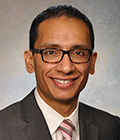- Anesthesiologists as Physician Executives: Another Career Path That Is Vital for Our Patients and Specialty
- Saturday, 1:10-3:10 p.m.
- McCormick Place West, W185bc
Physician executive has a nice ring to it. Anesthesiologist executive sounds even better. And increasingly, anesthesiologists are recognizing the C-suite as an appropriate and attainable goal.

Mohammed Minhaj, M.D., M.B.A.
“Becoming a hospital executive or chief executive makes sense because we are a hospital-based specialty that interacts with almost every other specialty,” said Mohammed Minhaj, M.D., M.B.A., Associate Professor of Anesthesia and Critical Care at the University of Chicago. “We are uniquely advantaged for becoming leaders in health care because we already work in the operating room and procedure suites and staff the ICUs. These sites are usually the biggest source of revenue and cost centers in most hospitals. Understanding from the inside how these can work most efficiently allows anesthesiologists to offer unique perspectives in running the entire organization.”
Finding your way to the top is not as difficult as it might seem. Dr. Minhaj is the co-moderator of “Anesthesiologists as Physician Executives: Another Career Path That is Vital for Our Patients and Specialty” with ASA CEO Paul Pomerantz. The session includes presentations from three anesthesiologists who have become health care executives leading major organizations.
Joanne M. Conroy, M.D., is Chief Executive Officer at Lahey Hospital and Medical Center, Burlington, Massachusetts. David L. Reich, M.D., is President and COO of Mount Sinai Hospital, New York. John M. Zerwas, M.D., served as president of Memorial Hermann Health Network Providers, Houston, is an ASA past president (2013) and an elected representative in Texas.
None of the trio followed a predictable anesthesiology career path.
On the private practice side, the path starts with residency, maybe a fellowship, followed by private practice and partnership. On the academic side, the path includes research, publishing, teaching, advancing to associate professor, full professor and possibly department chair. Increasingly, both paths can lead toward the C-suite.
There are several reasons anesthesiologists make good health system leaders, Dr. Minhaj said. One is familiarity.
Anesthesiologists have the luxury of experience working with almost every specialty represented in hospital practice. Interventional cardiologists, radiologists, different types of surgeons and other specialists all have their own focused perspectives. None of the perspectives are invalid, said Dr. Minhaj, they are just limited.
“Anesthesiologists work with almost every specialty and we deal with a broader range of patients than any of them,” he explained. “That means we see the issues from a broader perspective than any other specialty. This experience gives us a natural advantage over many other specialists when it comes to taking the system-wide view that is so important in leading a major organization.”
Most of the top hospital systems in the U.S. are run by physician executives, Dr. Minhaj said. Many anesthesiologists have served as deans of medical schools or academic institutions, supporting the theory that their work experiences ideally position them for leadership opportunities. However, many have never thought of hospital executive leadership as a career option, which makes this discussion an excellent opportunity to gain the perspectives of three distinguished leaders who have achieved a great deal of success in this realm.
“If you look at health care leadership from the outside, you need a perspective that is bigger than any one specialty,” Dr. Minhaj said. “You need that larger perspective that we can offer as anesthesiologists to best determine where the organization is headed and how it will get there. In this era of ever dynamic changes in health care, it is more important than ever that anesthesiologists consider all the career possibilities that are out there.”
Return to Archive Index